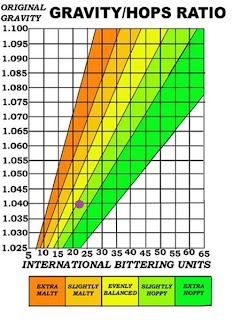 |
| LowTech IPA v1 |
LowTech IPA v2
OG 1.059/ IBU ~70/ SRM ~3.5/ ~41L
90.0% Pils Malt
05.0% Gambrinus Vienna Malt
05.0% Weyermann Rye Malt
10.15 AAU (.7oz) of Columbus @ 60 minutes
10.15 AAU (.7oz) of Columbus @ 30 minutes
25.40 AAU (2oz) of Chinook @ 12 minutes
21.80 AAU (2oz) of Centennial @ 12 minutes
13.60 AAU (2oz) of Cascade @ 12 minutes
Dry hop 1 oz (ea) Chinook/Centennial/Cascade for each 19L keg
WLP007
Brewed Apr 28th
Mashed in at 143F (mistake, too low), boiled water and infused to raise mash temperature to 146F (attempt to correct). Mashed for 60 minutes before collecting 46L pre-boil volume. Boiled for 70 minutes adding hops as scheduled above. Whirlfoc added at 5 min remaining in boil. I forgot to sanitize the pump so I ended up extending the boil time by 5 minutes. Gravity measured higher than anticipated, 1.063, may have collected slightly less than I had hoped for. Chilled to ~72F. Collected ~36-38L into two fermenters. Pitched 8 fl oz of thick yeast slurry into each fermenter. This is the second pitch on this yeast.
1.5 tsp Gypsum, 1.5 tsp Calcium Chloride, 1 tsp Epsom Salts, 210g Acid malt, added to mash for a pH of 5.48. 1 tsp Gypsum added to the boil. Final water numbers:
Ca 74, Mg 10, Na 18, Cl 50, SO4 157
Update Apr 29th
Both pails have significant Krausen.
Update May 8th
Airlock activity has completely stopped. Awaiting availability of a keg. Will dry hop directly in the keg this time. No secondary.
Update May 13th
FG 1.015. Both fermenters racked to keg. Dry hops added. Pressure set to 38psi.
Update May 15th
Pressure dropped to 12psi. Bagged dry hops caught in the Bev tube on both kegs. Beer is very turbid... something's wrong.
Update May 21st
Well, first failed batch in a while . Couple things went wrong, first and foremost, dry hopping in the keg with bagged pellets was a big mistake. I ended up racking out of the keg into another (losing 1/2 the batch in the process). In the future I will certainly stick to my secondary or primary dry hopping.
Secondly, I didn't get near the attenuation I was hopping for, the balance towards bitter, isn't where I want it to be. Too malty sweet for a good IPA. Back to the drawing board on this one, likely won't even do tasting notes as I've likely oxidized the beer pretty bad with on the racking and tickering.









